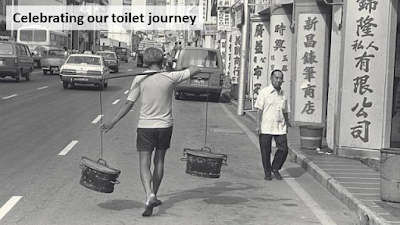SINGAPORE'S toilet journey is one to be proud of as we celebrate our country's 50th birthday and reflect on just how far our nation has come in its jubilee year.
I still remember clearly when the first flushing toilets were introduced in Singapore's Housing Board flats. My family wanted more than anything to move into a modern apartment with a flushing toilet. That happened in 1962, when we moved into a rental flat in Jalan Bahagia. I was five.
The indoor, flushing HDB toilets not only gave us convenience, safety, health and hygiene, but they were also seen as symbols of progress and gave us a sense of status and dignity, which is also very important for the pride of a nation.
I grew up in a kampung in Lorong Ong Lye near Paya Lebar Road. Growing up, our toilet, like that of most families, was a simple squat over wooden planks, with a bucket below it to capture the waste that was collected at night - the so-called "night-soil" bucket system.
It was very traumatic as a child to look down at all of the 50 shades of brown in the bucket, as well as used sanitary napkins and intestinal worms crawling while big green flies buzzed around.
I'm 58 this year. Just in my lifetime, I have witnessed how Singaporeans have enjoyed a better quality of life as toilets and sanitation have improved over the last 50 years as the nation progressed.
In the years under British rule in the 1960s, Singapore was a filthy, overcrowded city. Open defecation was rampant and, at best, our sanitation system was the "night-soil" bucket communal toilet system.
In rural areas at that time, pit latrines were shared by a number of families that consisted of a drop hole in the ground, with planks over the hole, located outside the houses. Once the pit was full, the waste was emptied manually and disposed of directly into nearby waterways. Public health was poor. Diarrhoea was widespread and frequent outbreaks of typhoid fever were caused by poor hygiene. The Singapore River was full of debris and faecal contamination.
With no natural resources and less than 600 sq km of land at that time, and without a sufficient water supply, the prevailing wisdom was that our island state would not be viable after its separation from Malaysia in 1965.
Yet, against all odds, its economy grew at an average of 8 per cent annually over the next 30 years, transforming Singapore from a "Third World country" to the country with the third-highest per capita GDP in the world.
One main component of this economic miracle was the concept of public health based on a "clean" strategy.
Improved cleanliness and hygiene reduced our health expenditure from 4.5 per cent of GDP in 1965 to 3 per cent of GDP consistently over the next three decades.
We invested more in the prevention of diseases so that we spent less on cures. By providing clean water and sanitation, we created a healthy, productive workforce that was ready for foreign investors to train and employ.
We installed an extensive sewerage network, which was later taken underground with the Deep Tunnel Sewerage System to optimise land space.
The cleaning up of the Singapore River took 10 years and was the cornerstone of Singapore's transformation into a clean city. By cleaning up the river and our waterways, we also prevented the spread of many diseases. Today with the Marina Barrage, we have turned the rivers into reservoirs for drinking water which we recycle continuously into Newater with an award-winning waste-water treatment plant.
We also cleaned up the streets and imposed heavy fines on people who litter. Today, the national culture is to hold on to a piece of rubbish until we find a dustbin to dispose of it.
The concept of "clean" was thus applied beyond clean toilets, to cleaning up the waterways and the environment, and greening the country. The idea of a "clean" mindset extended to cleaning up organised crime and corruption, and the resulting leaps forward in the quality of life in Singapore.
In 1998, inspired by then Prime Minister Goh Chok Tong's call for clean public restrooms as one of the markers of a gracious society during his 1996 National Day Rally speech, I decided to devote my life to improving sanitation. I founded Restroom Association Singapore, with the mission of raising the standards and cleanliness of public toilets in Singapore. Then in 2001, seeing the need for a global body to tackle the worldwide sanitation challenge, I founded World Toilet Organisation, and established World Toilet Day on Nov 19 to draw attention to the sanitation crisis.
In 2013, the United Nations General Assembly unanimously adopted Singapore's "Sanitation for All" resolution and officially declared Nov 19 as UN World Toilet Day, to be commemorated each year.
Singapore today is renowned globally for being a clean, green garden city, and our country's approach is an inspiration that holds valuable lessons for developing countries that are now seeking to tackle their sanitation challenges.
Addressing Singapore's sanitation challenge and taking a "clean and green" approach has led to an improved quality of life, a better environment and economic prosperity. Singapore's journey from a developing country with poor sanitation to one of the world's cleanest countries, with one of the strongest economies, is one for all of us to reflect on with pride in this SG50 year.
The next time you visit your flushing toilet, you should feel proud of our progress as a nation, while you remember that 2.5 billion people on this planet still do not have this privilege.
stopinion@sph.com.sg
http://bit.ly/1Q5VKGo






